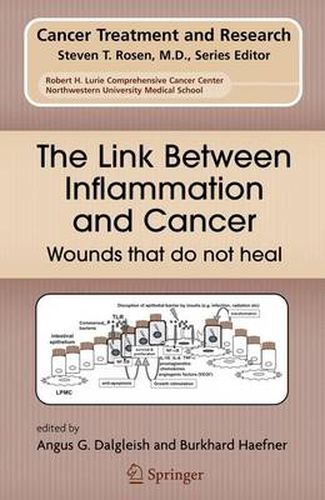Readings Newsletter
Become a Readings Member to make your shopping experience even easier.
Sign in or sign up for free!
You’re not far away from qualifying for FREE standard shipping within Australia
You’ve qualified for FREE standard shipping within Australia
The cart is loading…






This title is printed to order. This book may have been self-published. If so, we cannot guarantee the quality of the content. In the main most books will have gone through the editing process however some may not. We therefore suggest that you be aware of this before ordering this book. If in doubt check either the author or publisher’s details as we are unable to accept any returns unless they are faulty. Please contact us if you have any questions.
A link between inflammation and cancer has been established many years ago, yet it is only recently that the potential significance of this connection has become apparent. Although several examples of chronic inflammatory conditions, often induced by persistent irritation and/or infection, developing into cancer have been known for some time, there has been a notable resistance to contemplate the possibility that this association may apply in a causative way to other cancers. Examples for such progression from chronic inflammation to cancer are colon carcinoma developing with increased frequency in patients with ulcerative colitis, and the increased incidence of bladder cancer in patients suffering from chronic Schistosoma infection. Inflammation and cancer have been recognized to be linked in another context for many years, i.e., with regards to pathologies resembling chronic lacerations or ‘wounds that do not heal.’ More recently, the immunology of wound healing has given us clues as to the mechanistic link between inflammation and cancer, in as much as wounds and chronic inflammation turn off local cell-mediated immune responses and switch on growth factor release as well the growth of new blood vessels - angiogenesis. Both of these are features of most types of tumours, which suggest that tumours may require an immunologically shielded milieu and a growth factor-rich environment.
$9.00 standard shipping within Australia
FREE standard shipping within Australia for orders over $100.00
Express & International shipping calculated at checkout
Stock availability can be subject to change without notice. We recommend calling the shop or contacting our online team to check availability of low stock items. Please see our Shopping Online page for more details.
This title is printed to order. This book may have been self-published. If so, we cannot guarantee the quality of the content. In the main most books will have gone through the editing process however some may not. We therefore suggest that you be aware of this before ordering this book. If in doubt check either the author or publisher’s details as we are unable to accept any returns unless they are faulty. Please contact us if you have any questions.
A link between inflammation and cancer has been established many years ago, yet it is only recently that the potential significance of this connection has become apparent. Although several examples of chronic inflammatory conditions, often induced by persistent irritation and/or infection, developing into cancer have been known for some time, there has been a notable resistance to contemplate the possibility that this association may apply in a causative way to other cancers. Examples for such progression from chronic inflammation to cancer are colon carcinoma developing with increased frequency in patients with ulcerative colitis, and the increased incidence of bladder cancer in patients suffering from chronic Schistosoma infection. Inflammation and cancer have been recognized to be linked in another context for many years, i.e., with regards to pathologies resembling chronic lacerations or ‘wounds that do not heal.’ More recently, the immunology of wound healing has given us clues as to the mechanistic link between inflammation and cancer, in as much as wounds and chronic inflammation turn off local cell-mediated immune responses and switch on growth factor release as well the growth of new blood vessels - angiogenesis. Both of these are features of most types of tumours, which suggest that tumours may require an immunologically shielded milieu and a growth factor-rich environment.